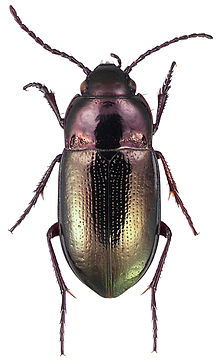| Trachypachidae Temporal range:
| |
|---|---|

| |
| Trachypachus gibbsii | |

| |
| Specimen of Systolosoma breve | |
| Scientific classification | |
| Domain: | Eukaryota |
| Kingdom: | Animalia |
| Phylum: | Arthropoda |
| Class: | Insecta |
| Order: | Coleoptera |
| Suborder: | Adephaga |
| (unranked): | Geadephaga |
| Superfamily: | Caraboidea |
| Family: | Trachypachidae C. G. Thomson, 1857 |
| Extan genera | |
|
Fossil genera, see text | |
The Trachypachidae (sometimes known as false ground beetles) are a family of beetles that generally resemble small ground beetles, but that are distinguished by the large coxae of their rearmost legs. There are only six known extant species in the family, with four species of Trachypachus found in northern Eurasia and northern North America, and two species of Systolosoma in Chile and Argentina. They were much more diverse in the past, with dozens of described species from the Mesozoic.[1]
Their habits are similar to those of the ground beetles; they are usually found in the leaf litter of conifer forests, and are thought to be mostly predators and scavengers, active during the day (diurnal).[2]
According to entomologist George Ball, "the most interesting thing about this small family is its uncertain phylogenetic relationships"; it has previously been classified as a subfamily of Carabidae, and as a family been placed in several different positions relative to other beetle families.[2] Recent molecular phylogenies have recovered as the sister group to the clade Carabidae+Cicindelidae as part of the Adephaga subgroup Geadephaga.[3][4] The earliest fossils known of this family are of the genera Petrodromeus, Permunda and Apermunda from the Permian-Triassic boundary of Russia around 252 million years ago.[5][6] Fossil genera of the family are classified in the subfamily Eodromeinae, while the two modern genera are placed in the subfamily Trachypachinae. The two subfamilies are distinguished by the shape and position of the sclerites that are jointed to the mesocoxae (the section where the middle pair of legs joins the body).[6]
- ^ Wang, Bo; Zhang, Haichun; Ponomarenko, Alexandr G. (2012). "Mesozoic Trachypachidae (Insecta: Coleoptera) from China". Palaeontology. 55 (2): 341–353. Bibcode:2012Palgy..55..341W. doi:10.1111/j.1475-4983.2012.01128.x. ISSN 0031-0239.
- ^ a b George E. Ball, "Trachypachidae", in Ross H. Arnett, Jr. and Michael C. Thomas, American Beetles (CRC Press, 2001), vol. 1
- ^ Vasilikopoulos, Alexandros; Balke, Michael; Kukowka, Sandra; Pflug, James M.; Martin, Sebastian; Meusemann, Karen; Hendrich, Lars; Mayer, Christoph; Maddison, David R.; Niehuis, Oliver; Beutel, Rolf G.; Misof, Bernhard (October 2021). "Phylogenomic analyses clarify the pattern of evolution of Adephaga (Coleoptera) and highlight phylogenetic artefacts due to model misspecification and excessive data trimming". Systematic Entomology. 46 (4): 991–1018. Bibcode:2021SysEn..46..991V. doi:10.1111/syen.12508. ISSN 0307-6970. S2CID 237486696.
- ^ Baca, Stephen M.; Gustafson, Grey T.; Alexander, Alana M.; Gough, Harlan M.; Toussaint, Emmanuel F. A. (October 2021). "Integrative phylogenomics reveals a Permian origin of Adephaga beetles". Systematic Entomology. 46 (4): 968–990. Bibcode:2021SysEn..46..968B. doi:10.1111/syen.12506. ISSN 0307-6970. S2CID 237486703.
- ^ Ponomarenko, A. G.; Volkov, A. N. (2013). "Ademosynoides asiaticus Martynov, 1936, the earliest known member of an extant beetle family (Insecta, Coleoptera, Trachypachidae)". Paleontological Journal. 47 (6): 601–606. Bibcode:2013PalJ...47..601P. doi:10.1134/S0031030113060063. ISSN 0031-0301. S2CID 84935456.
- ^ a b Cite error: The named reference
:1was invoked but never defined (see the help page).